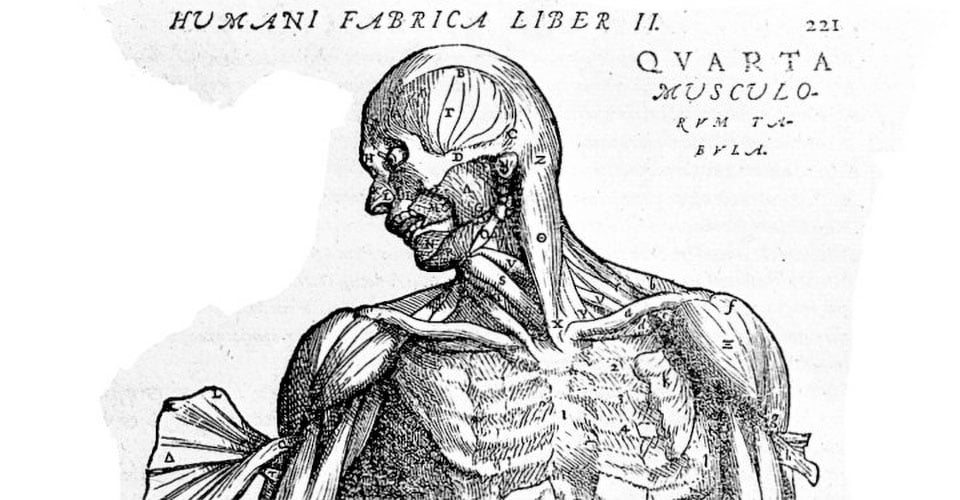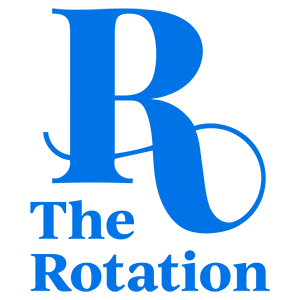In the first part of this series, we explored how, prior to the 14th century, art and science were inextricably linked and evenly applied in the ongoing pursuit of understanding the world around us.
In this installment, we examine the Renaissance and the Age of Enlightenment; two periods of time where these disciplines began to split – and look at what it meant for medical illustration.
Amongst turmoil, these were times of great political, technological, and artistic advancement. The world was growing smaller, and the people of the time were hungry for new ideas and innovations.
As a result, the art of medical illustrations flourished and started to become standardized, resembling more and more of what we recognize today.
The Renaissance (1300-1601 A.D.)
To the people of the Renaissance, art and science were not mutually exclusive pursuits. Few historical figures embodied this fusion as thoroughly as Leonardo da Vinci (1452-1519). Da Vinci’s determination to more accurately depict the human form in his art drove him to study its inner workings through dissections.
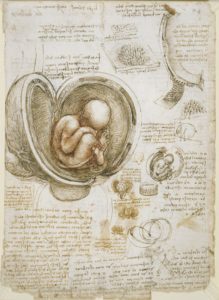
Despite the restored taboo—often enforced by law—on dissections, the legendary Italian thinker took part in at least 30 himself. He combined the era’s newfound emphasis on perspective with techniques he learned as an architect and engineer, to create a series of 800 anatomical drawings that bear a striking resemblance to the ones we see today in anatomy textbooks.
Layers are peeled away in three-dimensional cross-sections. Muscles are separated and grouped. The subjects are also in more natural and aesthetically pleasing poses than the rather awkward poses of the five figure series that predate them.
A century of development of the art of medical illustrations that followed da Vinci would likely have been wiped away by the advancements his work would have enabled, but he kept them tucked away. They were not published until the 19th century when dissections were a more accepted (and legal) part of medical research.
In 1522, Jacopo Berengario da Carpi—an Italian surgeon’s son who had become a renowned (and infamous) physician and anatomist in his own right—published Anatomia Carpi. Isagoge breves perlucide ac uberime, in Anatomiam humani corporis. It is considered the first known medical textbook to include illustrations.
Having studied printing under Aldus Manutius, the founder of the Aldine Press, his works deviated from the flat five figure series poses to ones that were more skillful and natural. De Carpi is credited for being one of the first to challenge the anatomical notions of legendary Roman medical scholar Galen, and describe the values of the heart.
A more famous contemporary of de Carpi was Andreus Vesalius, who, in 1543, published De Corpus Fabrica Humani Libri Septum. Vesalius was only 28, at the time.
Divided into six books, De Corpus Fabrica Humani Libri Septum contained 600 refined woodcut illustrations based on observations from human dissection. The work showcased a level realism and perspective that were characteristic of the Renaissance, while the illustrations themselves are beautiful works of art in their own right.
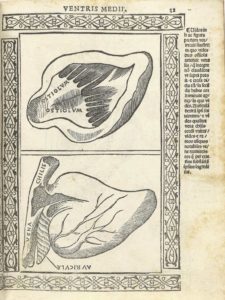
Vesalius’ inspiration to begin work on De Corpus Fabrica came from his efforts to translate Galen’s work De anatomicis administrationibus. At the time, the Roman text had been the unchallenged study standard for more than 1,300 years.
Vesalius was shocked to learn that Galen had never dissected a human, instead extrapolating human anatomy from dissections of animals. As a response, Vesalius leveraged his contacts with Johan van Calcar, a famed Venice illustrator, and began work on his first anatomical texts.
The resulting publications would go on to uncover at least 200 errors in Galen’s work, discoveries that earned Vesalius the ire and resentment of the more conservative elements of European academic society at the time. This would culminate in Vesalius receiving a death sentence for grave-robbing, a penalty commuted only upon his pilgrimage to the Holy Land.
Vesalius would get the last laugh. Not only would he go on to be physician to both the Holy Roman Emperor Charles V and Spain’s Philip II, but his work would remain relevant for centuries. Today, he is known as the Father of Modern Anatomy.
The Age of Enlightenment (18th Century)
If the Renaissance was a rebirth and re-exploration of new or formerly taboo ideas, the Enlightenment was about putting those ideas to action. Empiricism, rational thought, and progress became dominant, as the imaginations of the public were primed for even newer frontiers and ideas.
In many ways, the Age of Enlightenment was a natural progression of the themes the Renaissance started. Logic, reason, and humanism and their offshoots—inquiry and experimentation—continued to be valued and developed.
Yet while the Renaissance was a cultural movement that saw art, philosophy, spirituality, and science inextricably linked, the Age of Enlightenment was the beginning of what would become today’s hyper-specialized worldview.
The thinkers of this time concerned themselves mainly with the pursuit of science, mathematics, and technology. With the continued development of printing technology, their ideas would spread far and wide.
The studies of anatomy, biology, and physiology found themselves separated from more artistic pursuits like engraving, illustrating, and sculpture, putting the practice of medical illustrations in a precarious position.
Were they the realm of scientists, with their dispassionate dissections, analysis, and increasingly standardized methods or artists, with their wonder, whimsy, and unapologetic love for beauty and emotion?
Renaissance thinkers like Leonardo would have likely answered “both” – but times had changed. The Enlightenment’s desire to innovate and advance no longer tolerated art’s tendency to stop and muse about what it all means. There were old ideas to reexamine, ships to launch, and frontiers to tame, measure, and commoditize.
This conflict is exemplified by the partnership between Bernhard Siegfried Albinus, a well-known Dutch anatomist at Leiden University, and Jan Wandelaar, a painter, illustrator, and engraver from Amsterdam whose background included making anatomical drawings for another famed anatomist.
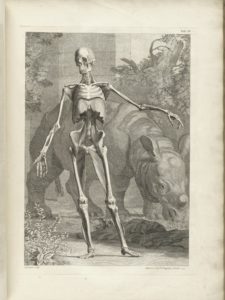
Art and science each played a key role in the pair’s work, but—this being the Enlightenment—science was given prominence. Albinus would lead the project and direct the more scientific parts of the illustration—where each anatomical piece belonged and the role it played—while Wandellar would take care of the art, in the form of exquisitely engraved copper plates and verdant backgrounds.
The men met in 1723 while collaborating with Herman Boerhaave, himself a distinguished Dutch botanist, chemist, and physician, on a new edition of Andreas Vesalius’s work. Two years later, the trio were collaborating on an ambitious project which would take 28 years to complete: the 40 engraved copper plates of Tabulae sceleti et musculorum corporis humani (Tables of the Skeleton and Muscles of the Human Body).
Devoted to muscular and skeletal anatomy, the illustrations in Tabulae sceleti et musculorum corporis humani were unprecedented in their accuracy because they were produced by men who were steeped in the empirical zeitgeist of the Enlightenment.
Albinus had a deep respect for the ‘perfect’ mechanics of the human body and wanted the images to impart an understanding of how it worked along mechanical, hydraulic, and mathematical laws. That meant nothing was to be left to chance, including the interpretations of an artist. Everything had to be carefully measured, examined, and reproduced in a way that ensured the most faithful reproduction possible.
Working together, Albinus and Wandelaar adopted new techniques aimed at eliminating skewed perspectives or guesswork. Among these was a relatively new method, for the age, that saw nets placed between the cadavers and skeletons they used as models and Wandelaar, the artist.
On Wandelaar’s sketchpad was a corresponding grid. Each square in the grid net was carefully evaluated, measured and reproduced on the sketchpad at a 90 degree angle (versus earlier single-perspective drawings that often produced a distorted figure). For the initial drawings, the grid was larger and the sketch produced quickly in broad strokes. Following the initial sketches, the size of the grid was reduced to ensure even greater accuracy and detail.
These were times of great political, technological, and artistic advancement. The world was growing smaller, and the people of the time were hungry for new ideas and innovations.
While Albinus was a stern and exacting taskmaster when it came to bodily depictions,often making Wandelaar redo drawings or etchings he found unsatisfactory, he let his partner do whatever he wanted with the backgrounds on the plates.
The result was a series of lush landscapes with tropical plants, hills, and mountains—even a rhinoceros (named Clara). In an age that saw art increasingly purged from science, the duo received criticism for the whimsical backgrounds they included on otherwise punctilious and straightforward plates.
What made Albinus and Wandleaar’s work so innovative and representative of their time were the rigorous methods and standards they set for accuracy, and the painstaking way they went about producing them. The figures were portrayed as masters of their environment, a mindset that defined an age of discovery and innovation.
Up Next: The Modern Era
The themes of veracity and empiricism established during the Age of Enlightenment carried through to the modern era, with new technologies unlocking a degree of accuracy that had never been seen before.
We’ll explore these developments and the widening gulf between art and science that ensued in the next installment. Stay tuned.


